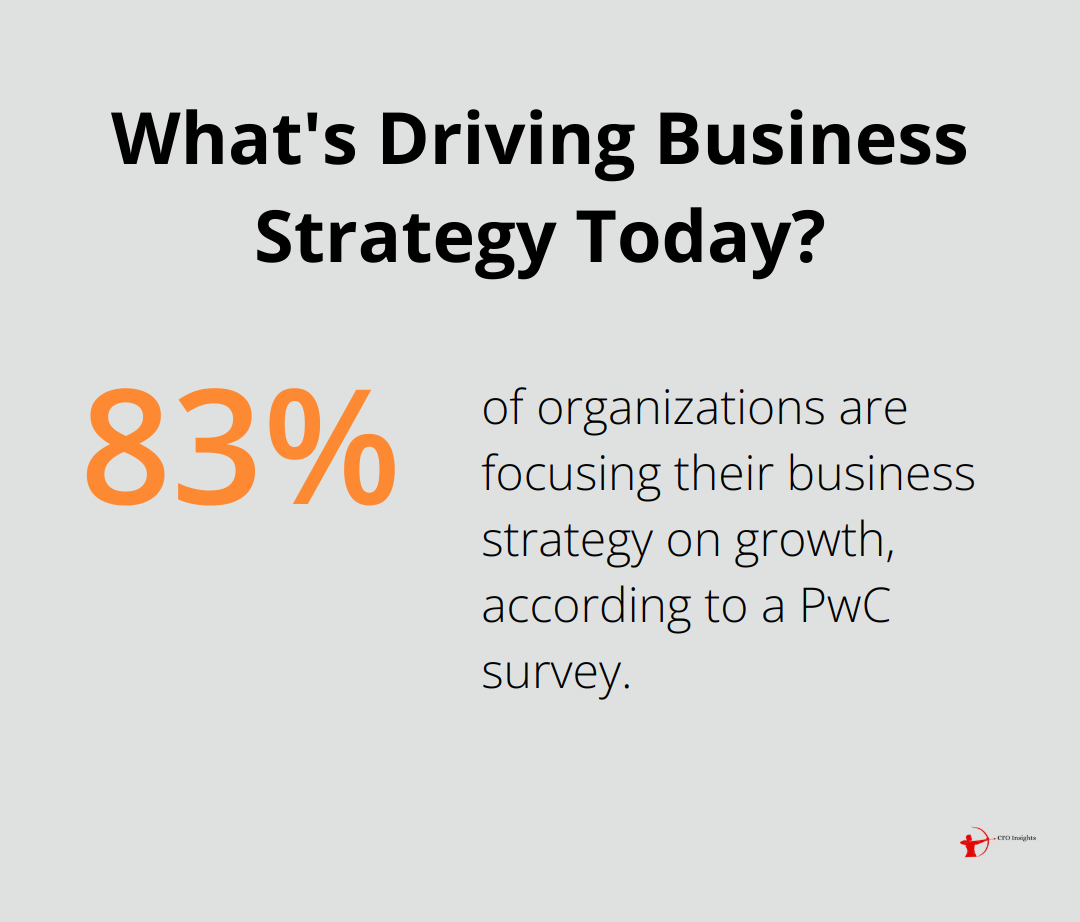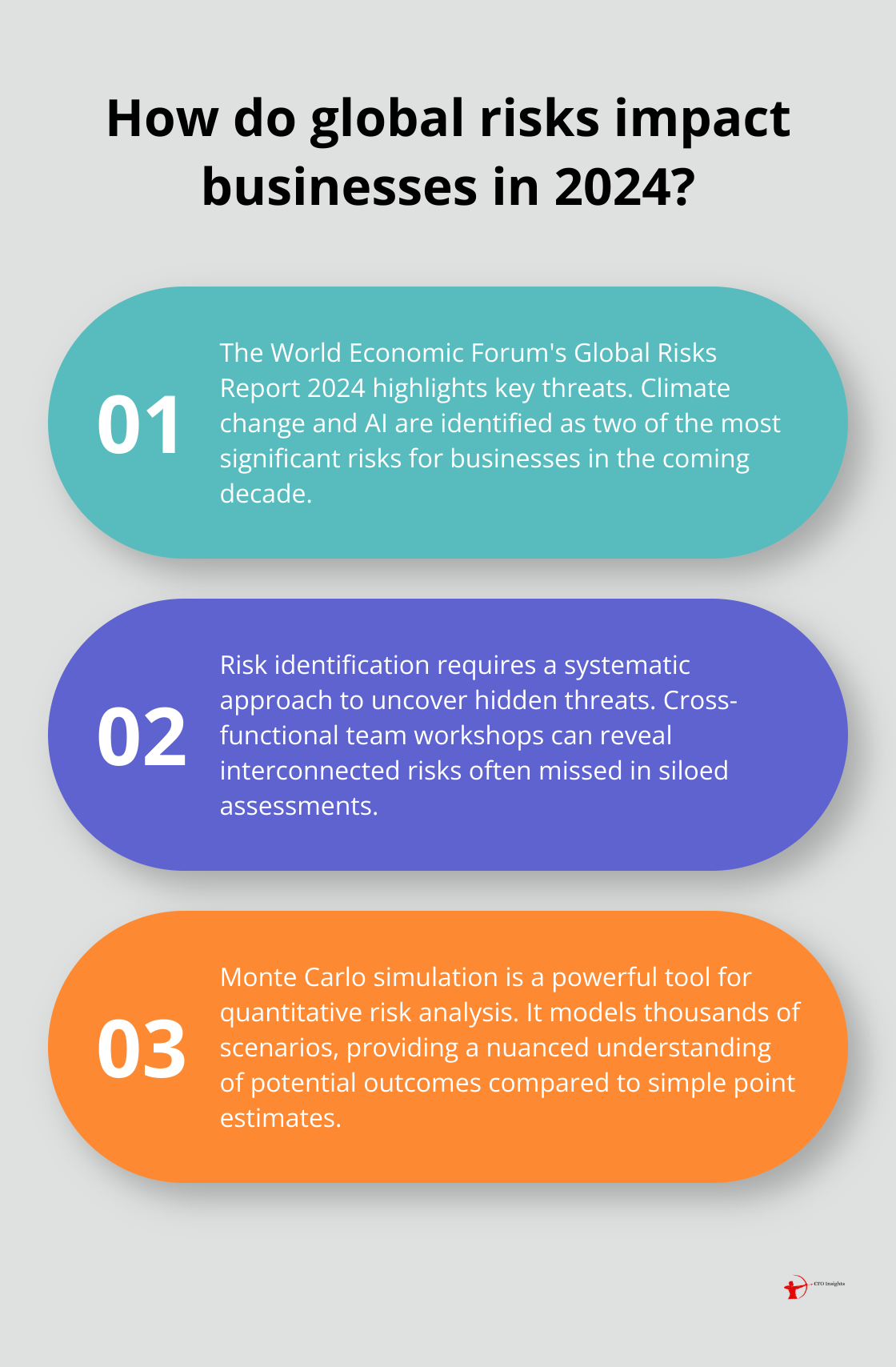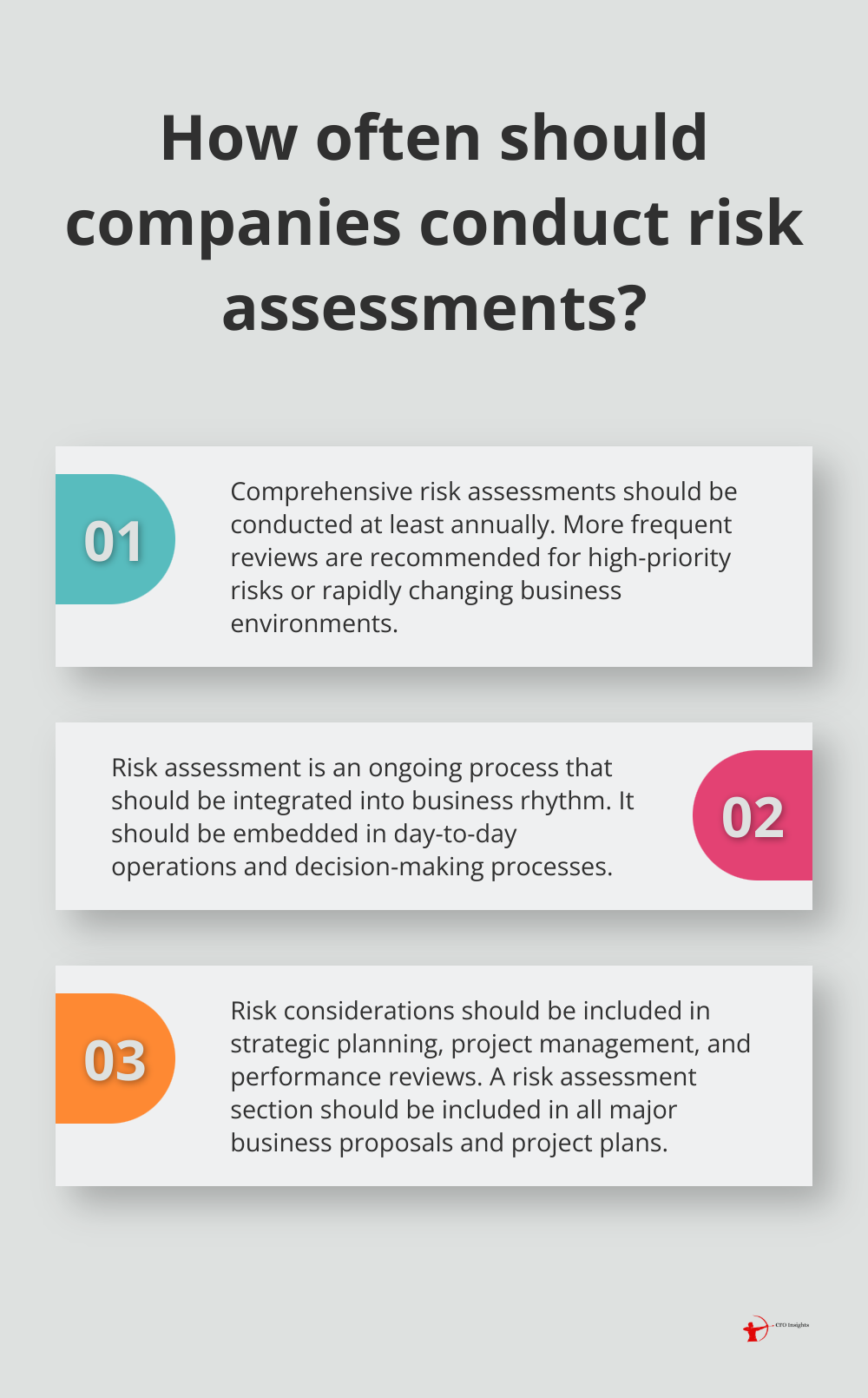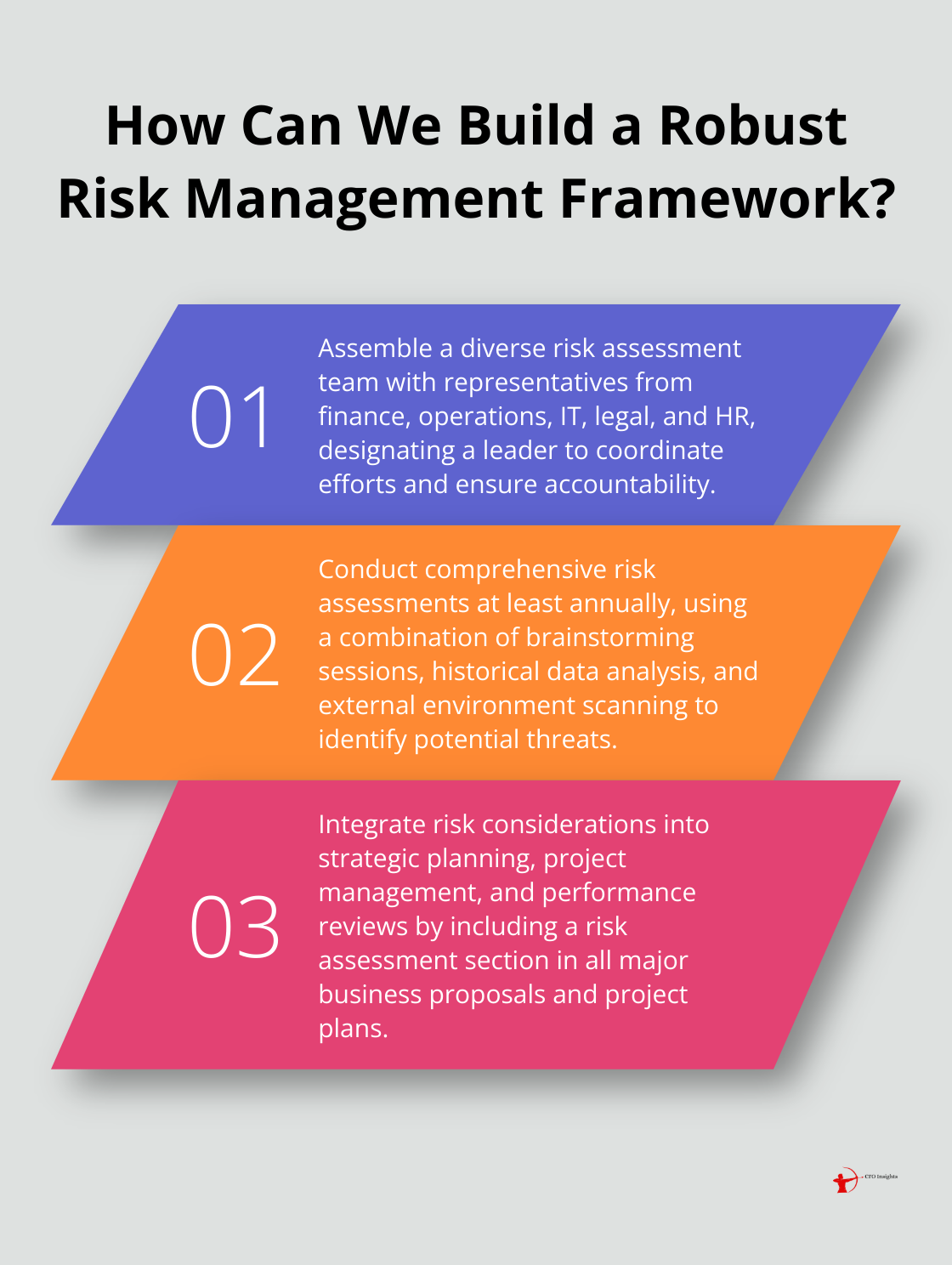At CFO Insights, we understand that effective risk management is vital for business success. Risk assessment forms the foundation of this process, enabling executives to identify, analyze, and mitigate potential threats to their organizations.
In this guide, we’ll explore the key components of a comprehensive risk assessment and provide practical steps for implementation. By the end, you’ll have the tools to strengthen your company’s risk management strategy and make more informed decisions.
What Is Risk Assessment?
Definition and Scope
Risk assessment is the systematic process of identifying, analyzing, and evaluating potential threats to an organization’s assets, operations, and objectives. This process forms the cornerstone of effective risk management, enabling businesses to anticipate and mitigate potential issues before they escalate.
The Importance of Risk Assessment
Risk assessment transcends mere compliance; it’s a critical business function that directly impacts an organization’s success. A recent PwC survey revealed that more than four-fifths (83%) of organizations are focusing their business strategy on growth, underscoring the link between effective risk management and business performance.
Types of Risks
Financial Risks
Financial risks involve potential losses due to market changes, credit issues, or liquidity problems. The 2008 financial crisis serves as a stark reminder of the devastating impact of unmanaged financial risks.
Operational Risks
Operational risks stem from internal processes, systems, or human errors. A 2024 IBM report highlighted the financial impact of operational risks, revealing that the average cost of a data breach was $4.88 million.
Strategic Risks
Strategic risks arise from poor business decisions or failure to adapt to market changes. Kodak’s bankruptcy in 2012 exemplifies a company’s failure to adapt to digital photography, resulting in a strategic risk that cost the company its market position.
Compliance Risks
Compliance risks involve legal and regulatory issues. Facebook’s $5 billion fine by the Federal Trade Commission in 2019 for privacy violations demonstrates the severe consequences of compliance failures.
Risk Assessment in Decision-Making
Risk assessment plays a pivotal role in informed decision-making. It provides executives with a clear picture of potential threats and opportunities, allowing for more strategic choices. For example, when considering expansion into new markets, a thorough risk assessment can reveal potential regulatory hurdles, cultural differences, or economic instabilities that might impact success.
Implementing Effective Risk Assessment
To implement an effective risk assessment process, organizations should:
- Establish a dedicated risk management team
- Develop a comprehensive risk register
- Use quantitative and qualitative analysis methods
- Regularly review and update risk assessments

These steps help create a culture of risk awareness and proactive management within the organization.
As we move forward, we’ll explore the key components of a comprehensive risk assessment in greater detail, providing you with the tools to strengthen your company’s risk management strategy and make more informed decisions.
Building Your Risk Assessment Framework
Identifying Risks: Beyond the Obvious
A robust risk assessment framework transforms an organization’s approach to managing threats and opportunities. Risk identification requires a systematic approach that uncovers both obvious and hidden risks. Risk workshops, where cross-functional teams collaborate, can reveal interconnected risks that might be missed in siloed assessments.

External data analysis provides valuable insights into emerging global threats. The World Economic Forum’s Global Risks Report (2024) highlighted climate change and AI as two of the most significant risks facing businesses in the coming decade.
Analyzing Risks: Quantifying the Unknowns
After risk identification, the next step analyzes their potential impact and likelihood. Many organizations rely on subjective assessments rather than data-driven approaches.
Monte Carlo simulation is a powerful quantitative tool often used in risk analysis. This approach provides a more nuanced understanding of potential outcomes compared to simple point estimates. For example, when assessing the financial impact of a potential supply chain disruption, a Monte Carlo simulation could model thousands of scenarios, accounting for variables like supplier reliability, transportation costs, and market demand fluctuations.
Prioritizing Risks: Focus Where It Matters
Effective risk management requires prioritizing risks based on their potential impact and the organization’s risk appetite. A risk heat map visualizes and prioritizes risks by plotting them based on their likelihood and potential impact, allowing decision-makers to quickly identify which risks require immediate attention.
It’s important to avoid focusing solely on high-impact, high-likelihood risks. Low-likelihood, high-impact events (often called “black swan” events) can be equally devastating if not properly managed.
Mitigating Risks: Proactive Strategies
The final component of a comprehensive risk assessment framework develops strategies to mitigate identified risks. This involves creating actionable plans to reduce their likelihood or impact.
Contingency plans are pre-defined action plans that can be quickly implemented if a risk materializes. For example, a tech company might develop a contingency plan for a major data breach, outlining steps for containment, customer communication, and regulatory compliance.
Risk transfer is another key strategy. This could involve purchasing insurance policies or entering into contractual agreements that shift some of the risk to other parties. However, while risk can be transferred, the ultimate responsibility often remains with the organization.
A comprehensive risk assessment framework is not a one-time exercise but an ongoing process that should integrate into an organization’s strategic planning. The next chapter will explore how to implement this framework effectively within your organization, ensuring that risk management becomes a cornerstone of your decision-making process.
How to Build a Robust Risk Assessment Process
Assemble Your Risk Assessment Dream Team
The first step in creating an effective risk assessment process is to assemble the right team. This team should include representatives from finance, operations, IT, legal, and human resources. Each member brings a unique perspective on potential risks within their domain.
A study by McKinsey found that although the business case for diversity, equity, and inclusion (DE&I) is stronger than ever, many companies’ progress has stalled. However, diversity alone isn’t enough. Your team needs clear roles and responsibilities. Designate a risk assessment leader who will coordinate efforts and ensure accountability.
Create a Tailored Risk Assessment Framework
Risk assessment frameworks should align with your organization’s specific needs, industry, and risk appetite. Start by defining your risk categories. These typically include financial, operational, strategic, and compliance risks, but may also include categories specific to your industry.

Next, establish a consistent methodology for assessing risks. This should include criteria for evaluating likelihood and impact, as well as a system for prioritizing risks. Many organizations use a 5×5 risk matrix, but a 3×3 matrix often provides sufficient granularity while being easier to use consistently across the organization.
Conduct Regular Risk Assessments
Risk assessment isn’t a one-time event. It’s an ongoing process that should integrate into your business rhythm. We recommend conducting comprehensive risk assessments at least annually, with more frequent reviews for high-priority risks or rapidly changing business environments.
Use a combination of methods to identify risks, including brainstorming sessions, historical data analysis, and external environment scanning. The World Economic Forum’s annual Global Risks Report is an excellent resource for understanding emerging global risks that could impact your business.
When you analyze risks, move beyond subjective assessments. Use quantitative methods where possible. For example, when you assess the financial impact of a potential cyber attack, use data from industry reports and your own IT infrastructure to model potential losses.
Embed Risk Assessment in Business Operations
For risk assessment to be truly effective, you need to embed it in day-to-day operations and decision-making processes. This means integrating risk considerations into strategic planning, project management, and performance reviews.
One effective approach is to include a risk assessment section in all major business proposals and project plans. This ensures that you consider risk proactively, rather than as an afterthought.
Additionally, consider implementing a risk management software solution. These tools can help streamline the risk assessment process, improve data visualization, and facilitate real-time risk monitoring. According to OCEG, discovering the true value of a GRC system goes beyond merely measuring its activities like risk assessment or policy management.
Leverage Expert Guidance
While building an internal risk assessment process is essential, leveraging external expertise can provide valuable insights and best practices. CFO Insights specializes in providing fractional CFO services that can support your risk assessment efforts. Our experienced professionals can help you implement best practices in financial management, improve cash flow, and support growth initiatives (all while ensuring that you receive personalized attention and customized solutions that fit your unique needs).
Final Thoughts
Risk assessment stands as a critical business function that shapes organizational success. Companies that prioritize risk management often experience improved operational efficiency, enhanced stakeholder trust, and increased resilience against unexpected challenges. A well-executed risk assessment framework uncovers valuable insights that inform strategic planning and resource allocation, ultimately contributing to a stronger competitive position.

Executives must evaluate their current risk assessment practices and identify areas for improvement. They should consider partnering with experts who provide guidance and support in implementing best practices. At CFO Insights, we help organizations optimize their financial strategies, including risk management.
Our fractional CFO services offer the expertise needed to develop and implement a comprehensive risk assessment process tailored to unique business needs. Organizations can focus on core operations while ensuring their financial strategies build on a solid foundation of risk awareness and mitigation. Risk assessment positions organizations for sustainable success in today’s rapidly evolving business environment.




